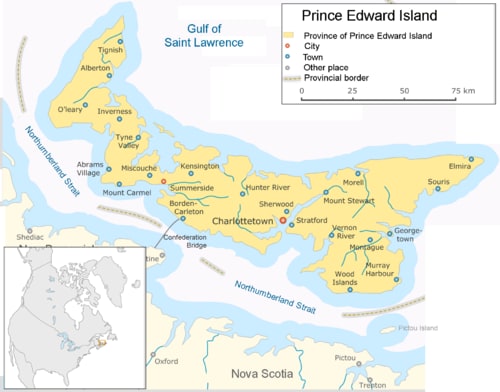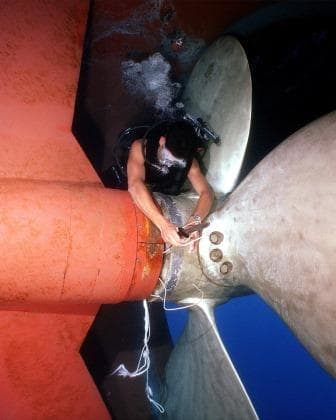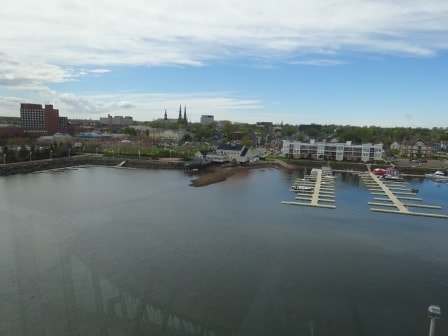Just after midnight the water and air temperature got in balance and a white cloud descended over Northhumberland Strait. This is the stretch of water which separates Prince Edward Island or PEI from the rest of Canada and as the Maasdam was in the middle of that Strait we did not see anything anymore. And so it remained until arrival. Looking at the positive side it meant, no more rain but sunny periods during the day, even if it was chilly. Steam was coming off the aft swimming pool and that you only see when it is chilly, cold or freezing.
Charlottetown is the largest town on the island and has grown around three rivers which all dump their water in the harbor area. It has a nice Cruise ship dock, long time ago inaugurated by yours truly with the Veendam when it was transformed from a small cargo dock into something which the locals can be proud about. The town is named after a British Queen – Consort of King George III (Although she herself was German) and it has the claim to fame as being the birthplace of the Canadian Confederation. In 1864 the Charlottetown Conference was held here with the aim to unify the area which we now know as Canada.
Sailing into Charlottetown can be quite spectacular as the ship sails into a sort of lagoon with cliffs on both sides. These cliffs are of a red clay type material and give the area a very unique view. The port itself is located in the back and quite nicely sheltered. If there are more cruise ships in port then there is also an anchorage and that is less nice. The three rivers converge here and there is the tide. In total four forces of current hitting the ship at anchor. At a normal anchorage the ship swings around on the tide and then settles with the bow into the flow. Not here as the resulting influence of those four forces constantly changes and keeps pushing the ship one way or the other. It is constantly swinging around the anchor and it never settles. I have been here at anchor only once (and that was more than enough) and during a four hour period (without a change from Ebb to Flood) the ship made three complete turns around the anchor. It only settled to some extent when the wind picked up; but we do not like that either as it means a choppy ride for the tenders. Luckily normally Holland America Line ships dock as we have been coming here as one of the first cruise companies and are very regular in our calls. In some ports seniority still counts for something.

Prince Edward Island. The Confederation Bridge location can be seen on the lower left. (Courtesy Wikipedia)
On the island there are plenty of things to see and do and some of the tours also go off the island as there is a bridge connection with the mainland. The Maasdam will sail under it tonight and it takes about 3 hrs. from the dock to get there. It saves quite a few miles to take this route as otherwise you have to back track and sail around the whole of the East side of PEI.
Sailing under the Confederation Bridge is a mixed blessing. It is very nice to do and quite spectacular as the old Westerdam just fitted under it but the area is full of lobster pots and as lobsters do not tend to pay much attention to steamer routes, the fishermen tend to have the same attitude and set the pots wherever the lobsters might be. If one is in the channel then we can sail around it and then there is a chance the rope between the lobster pot and the indicator buoy at the surface might get in the propeller. To avoid damage we have little knife tips permanently attached to the inner edge of the propeller to cut the rope before it hits the seal. Especially plastic fishing lines can cut into the seals of the pitch propeller blades and can cause oil leaks. Although the hydraulic oil we use is environmental friendly and does not pollute the environment, we still do not want leaks.

One way of getting the ropes out is by diver and we have to do that some times. We have little knife blades at the rim of the propeller end, exactly where the diver has his hands & knife. (Photo courtesy website osd.dtic.mil)
This evening we sail at 1800 and head to the St. Lawrence Pilot station and then tomorrow we will spend the day on the river, heading towards Quebec. Weather for tomorrow chance of rain and chilly, if it will bring haze, we will see.


May 25, 2017 at 1:25 pm
Interesting about the ropes and the propellers. But I am interested: What is the procedure for assuring that no power will be applied to the propeller shafts while they are being attended to by a diver?
May 25, 2017 at 6:00 pm
Thank you for reading my blog.
That answer I can easily give. The chief electrician pulls the main breakers out of the main switchboard, so nothing can work or be switched on anymore
until the Bridge officer together with the Chief Engineer (it takes two people for a positive confirmation) advises that all divers are confirmed
out of the water. Also we put a brake on the propeller shaft to make sure it does not start rotating on the current in the water.
That is our side of the evolution. The diving company has its own checklists and confirmation system so it knows the ship will not
do something un-expected.
Best regards
Capt. Albert
May 26, 2017 at 11:50 am
Hi Capt Albert:
I am actually responding to your 27 May blog, as not everyone of yoiur blogs offers an opportunity to comment.
The last time I remember you commenting about the St. Laurence River pilot was when you were Master of the Veendam, on a Montreal to Tampa cruise. The Canadian pilot was ordering a certain speed to minimize shore erosion, but you commented you knew exactly at what speed the Veendam caused minimum wake, and that wasn’t it !!
Anyway I am overdue in welcoming you back. Looking forward to your blogs as always.
May 26, 2017 at 4:35 pm
Thank you,
The Maasdam captain will have the same thing tonight when he is in the Trois Rivieres area. He also will need to find a careful balance to slowing down what is needed and taking into consideration that just slowing down is not the answer. It all depends on the wake the ship makes at certain speeds, a pilot does not know the ship and thus might go for a “slow speed” which actually might results in more swell than a higher speed.
Best regards
Capt. Albert